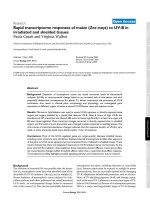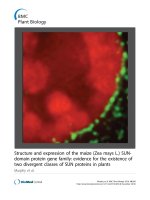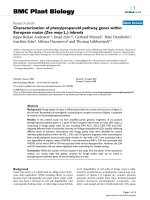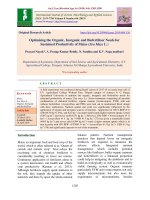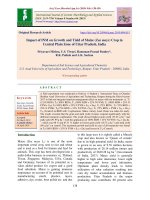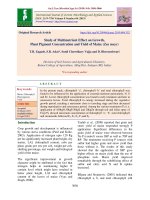Turcicum leaf blight: A ubiquitous foliar disease of maize (Zea mays L.)
Bạn đang xem bản rút gọn của tài liệu. Xem và tải ngay bản đầy đủ của tài liệu tại đây (312.57 KB, 7 trang )
Int.J.Curr.Microbiol.App.Sci (2017) 6(3): 825-831
International Journal of Current Microbiology and Applied Sciences
ISSN: 2319-7706 Volume 6 Number 3 (2017) pp. 825-831
Journal homepage:
Review Article
/>
Turcicum Leaf Blight: A Ubiquitous Foliar Disease of Maize (Zea mays L.)
Dan Singh Jakhar*, Rajesh Singh, Saket Kumar, Pargat Singh and Vivek Ojha
Department of Genetics and Plant Breeding, Institute of Agricultural Sciences,
Banaras Hindu University, Varanasi – 221005, UP, India
*Corresponding author
ABSTRACT
Keywords
Turcicum Leaf
blight, Exserohilum
turcicum, Foliar
Disease, Maize.
Article Info
Accepted:
15 February 2017
Available Online:
10 March 2017
Turcicum leaf blight (TLB) or Northern Corn Leaf Blight (NCLB) is a ubiquitous foliar
disease of corn (maize) caused by Exserohilum turcicum, the anamorph of the ascomycete
Setosphaeria. The TLB fungus survives through the winter on infected maize residue at the
soil surface. As temperatures rise in the spring and early summer, the fungus produces
spores on residue, and then the spores are splashed or wind-blown onto leaves of the new
maize crop. Infection occurs during periods of moderate (64° to 81°F), wet and humid
weather. The disease begins as long, slender, grayish or tan leaf lesions that run parallel to
the mid vein. Lesions can eventually expand to a more oblong or “cigar” shape. Lesions
may also form on husks. Loss of photosynthetic tissue can result in decreased yield, and
silage quality can be affected. Effective management practices that reduce the impact of
TLB include selecting resistant cultivars, reducing maize residue, timely planting and
applying foliar fungicides.
Introduction
Maize is the world’s third leading cereal crop,
after wheat and rice. It most probably
originated in Central America, specifically
Mexico and spread Northward to Canada and
Southward to Argentina. As per the USDA
report of May, 2016, the world maize
production has been estimated about 96.88
crore tonnes in 2015-16 which is 4.6 per cent
lower than last year (101.35 crore tonnes).
Turcicum leaf blight is a common disease of
maize in many parts of the world including
India (Figure 1). Turcicum leaf blight is a
common disease of maize in many parts of
the world including India. Turcicum Leaf
bright incited by the ascomycete Setosphaeria
turcica, Anamorph Exserohilum turcicum. It
was first reported in the USA in New Jersey
in 1878, this was followed by a serious
outbreak of Turcicum leaf blight in
Connecticut in 1889 (Drechsler, 1923).
Turcicum leaf blight is favored by mild
temperature and high humidity (Ullstrup,
1970). Heavy dews, cool temperature and
frequent rains create good environmental
conditions for disease development (Jordan et
al., 1983). TLB in India, the disease is
prevalent in Karnataka, Himachal Pradesh,
Uttarakhand, Uttar Pradesh, Orissa, Andhra
Pradesh, North Eastern Hill state and also
affects Rabi maize in plains. It reduces the
grain yield of maize considerably all over the
world. Grain yield can be reduced to 50%
when TLB become severe before either
qualitative (Monogenic) or quantitative
(Polygenic) flowering (Raymundo et al.,
1981; Tefferi et al., 1996). Resistant cultivars
825
Int.J.Curr.Microbiol.App.Sci (2017) 6(3): 825-831
have been used extensively to control TLB.
Diverse sources of qualitative and quantitative
resistance are available. Qualitative or
monogenic resistance is race specific often
unstable and depends upon environmental
conditions. This type of resistance is
conferred by Ht genes (Gevers, 1975; Hooker,
1977; 1981; Robbins and Warren, 1993) and
by many unnamed genes (Carson, 1995).
These genes are mostly characterized by
chlorotic lesion responses. Quantitative or
polygenic resistance is normally race
nonspecific. This type of resistance is
expressed
independently
of
physical
environment and largely insensitive to
varying light and temperature conditions
(Carson and van Dyke, 1994). Quantitative
TLB resistance is durable in nature and
characterized by fewer and sometime smaller
lesions and a prolonged incubation period but
not reduced sporulation (Ullstrup, 1970;
Brewster et al., 1992; Smith and Kinsey,
1993).
23, 23N and 123N (Table 1). Ferguson and
Carson (2007) reported a survey of TLB races
which indicated that frequency of Race 0
isolates decreased from 83% in 1974 to 50%
in the 1990s. Two types of resistance are
available to protect against these races: partial
resistance (non-race specific), which is
controlled by multiple genes and protects
against all known races of the fungus, and
race-specific resistant, which is controlled by
single Ht genes (Ht1, Ht2, Ht3, and HtN) and,
as the name suggests, protects against specific
races of the pathogen. Partial resistance and
resistance conferred by HtN are expressed as
a reduction in the number and size of the
lesions, whereas resistance conferred by Ht1,
Ht2, and Ht3 is expressed as small chlorotic
lesions. A compatible interaction between Ht
genes and races of the pathogen results in a
susceptible lesion type, large necrotic cigarshaped lesions
(Figure 2) whereas
incompatible interactions result in small
chlorotic lesions (resistant lesion type). For
instance, race 1 of the fungus causes large
necrotic cigar-shaped lesions on cultivars with
Ht1, but small chlorotic lesions on cultivars
with Ht2, Ht3, or HtN.
Symptoms
The characteristic symptom of turcicum leaf
blight on a susceptible cultivar is one-to-six
inch long cigar-shaped gray- to tan-colored
lesions on the leaves (Figure 2). However,
before lesions are fully developed, they first
appear as small light-green to grayish spots
approximately 1-2 weeks after infection. As
the disease develops, the lesions spread to all
leafy structures, including the husks, and
produce dark gray spores, giving lesions as
dirty appearance. The lesions may become so
numerous that the leaves are eventually
destroyed, causing major yield loss due to
reduction in the available of carbohydrates to
fill the grain. The leaves then become
grayish-green and brittle, resembling leaves
killed by frost.
Disease cycle and epidemiology
The fungus causing TLB overwinters as
mycelia and conidia on maize residues left on
the soil surface. Conidia may also be
transformed into thick-walled resting spores
called chlamydospores. During warm, moist
weather in early summer, new conidia are
produced on the old maize residue and carried
by the wind or rain to lower leaves of young
maize plants. Infection and disease
development are favored by heavy dew,
frequent rainfall, high humidity, and moderate
temperatures. Infection by germinating
conidia occurs when free water is present on
the leaf surface for 6-18 hours and the
temperature is between 66 and 80°F (1827°C). Under favorable conditions, lesions
develop and produced a new crop of spores
Races of turcicum leaf blight
Several physiological races of the fungus are
known to occur, including races 0, 1, 2, 12,
826
Int.J.Curr.Microbiol.App.Sci (2017) 6(3): 825-831
within 7-12 days on susceptible cultivars,
causing the disease to spread rapidly.
Secondary spread from lower to upper leaves
and among plants within a field results
primarily from spores being splashed around
by rain, whereas wind is responsible for longdistant spore movement and spread of the
disease from one field to another (Figure 3).
blighting. Under severe infestation, sugars can
be diverted from the stalks for grain filling
leading to crop lodging. If TLB establishes
before silking and spreads to upper leaves
during grain filling, severe yield losses can
occur. Crop lodging is a particular concern
where maize is mechanically harvested. In dry
conditions, TLB is rarely an important disease
of maize. Yield losses as high as 70% have
been recorded due to TLB. Typically,
however, yield losses range from 15 to 30%.
Disease inoculation and assessment
TLB will be induced by inoculation the
spreader rows and all plots. Conidial
suspensions prepared from S. turcica will be
used to inoculate each plant at the 4-6 leaf
stage. Disease assessment at each location
will conducted in the field after onset of the
disease. Ten randomly selected plants in the
center row will be tag and used for successive
disease assessments. Plants will be rated at-10
day intervals for percent incidence, the
number of lesion on the ear leaf and second
leaf above the ear leaf on each tagged will
also counted two leaves per plants. Disease
severity will be rated followed by CIMMYT
methods using 1-5 scoring scale (Table 2 &
Figure 4). E. turcicum severity rating will do
as follow.
Management practices
Resistant cultivars
Planting resistant cultivars is the most
effective method for controlling TLB. Partial
resistance protects against all four of the
known races of the fungus and reduces the
rate of disease development by reducing the
number and size of the lesions and the amount
of spores produced in these lesions, as well as
increasing the length of the incubation and
latent periods. Race-specific resistance
protects against specific races of the fungus,
reducing disease development by producing
chlorotic lesion with limited and delayed
sporulation. Resistant cultivars should be
planted in all commercial dent maize
production fields. Select cultivars with high
levels of partial resistance in combination
with Ht1, Ht2 or other Ht genes.
Damage
Yield loss is caused predominantly through
loss of photosynthetic leaf area due to
Table.1 Common sources of resistance Ht genes
Races of
Exserohilum
turcicum
0
1
2
12
23
23N
123N
Ht1
R
S
R
S
R
R
S
Resistance genes
Ht2
Ht3
R
R
S
S
S
S
S
827
R
R
R
R
S
S
S
HtN
R
R
R
R
R
S
S
Int.J.Curr.Microbiol.App.Sci (2017) 6(3): 825-831
Table.2 Scoring of Turcicum leaf blight disease
Symptoms
Symptoms
Severity Grade
0
Responsive Value
Very slight to
Slight infection
Light infection
1
Moderate infection
3
Heavy infection
4
Very heavy
infections
5
One, two or few scattered lesions
on lower leaves.
Light infection, Moderate number
of lesion on lower Leaves only
Abundant lesion on lower leaves,
few on middle leaves
Lesions abundant on lower and
middle leaves, extending to upper
leaves
Lesion abundant on almost all
leaves plants prematurely dry or
killed by the disease.
No symptoms
2
0
Disease
Reaction
Symptom less
Highly
resistant
Resistant
Moderately
resistant
Susceptible
Highly
susceptible
Table.3 Maize foliar fungicides and efficacy against NCLB. Adapted from Wise, 2015
Fungicide/
Company
Aproach®
DuPont
Aproach Prima
DuPont
Domark®
Valent
Headline® AMP
BASF
Headline® EC
Headline® SC
BASF
Quadris®
Syngenta
Quilt®
Quilt® Xcel
Syngenta
Stratego® YLD
Bayer
Tilt®
Syngenta
Active Ingradients
Picoxystrobin
picoxystrobin+cyproconazole
Tetraconazole
pyraclostrobin+ metconazole
Pyraclostrobin
Azoxystrobin
propiconazole & azoxystrobin
prothioconazole &
trifloxystrobin
Propiconazole
828
Chemical
Group
methoxyacrylates
methoxyacrylates &
triazoles
Triazoles
NCLB
Efficacy
very good
methoxycarbamates &
triazoles
methoxycarbamates
very good
methoxyacrylates
trizoles &
methoxyacrylates
trizoles &
oximinoacetates
Triazoles
Good
very good
no data
very good
very good
very good
Good
Int.J.Curr.Microbiol.App.Sci (2017) 6(3): 825-831
Fig.1 Geographic distribution of turcicum leaf blight
Fig.2 Typical cigar shaped lesion of turcum leaf blight on maize leaf
Fig.3 Disease cycle of turcicum leaf blight of maize
829
Int.J.Curr.Microbiol.App.Sci (2017) 6(3): 825-831
Fig.4 Disease Score (1-5-point scale) for field evaluation of TLB of maize
growers to protect against several common
leaf diseases, TLB may not always be
controlled as completely as some other
diseases. This is because of the more rapid
life cycle of TLB, which may be as short as 1
week under favorable conditions. Because
TLB sporulates so rapidly, it is more difficult
to time a single fungicide application.
Consequently, selecting resistant cultivars is a
crucial first step in managing TLB where
incidence is historically high.
Reducing previous maize residue
Reducing maize residue decreases the amount
of TLB inoculums available to infect the
subsequent crop. A one- to two-year rotation
away from maize and destruction of old maize
residues by tillage will be helpful for
controlling TLB.
Timely planting
Timely planting can often help cultivars
escape the most severe damage from TLB if
crop development outpaces normal disease
progression. The latest-planted maize in an
area may be infected when plants are smaller,
resulting in the disease progressing more
rapidly relative to the crop. However, in cases
of high disease incidence, both early- and
late-planted maize may be severely damaged.
References
Brewster, V.A., Carson, M.L., Wicks, Z.W.
ІІІ. 1992. Mapping components of
partial resistance to northern leaf blight
of maize using reciprocal translocations.
Phytopathol., 82: 225-229.
Carson, M.L. 1995. Inheritance of latent
period length in maize infected with
Exserohilum turcicum, Plant Dis., 79:
581-585.
Carson, M.L., Van Dyke, C.G. 1994. Effect of
light and temperature on expression of
partial resistance of maize to
Fungicide application
Various foliar fungicides are available to help
control or suppress TLB development (Table
3). Though fungicides are routinely used by
830
Int.J.Curr.Microbiol.App.Sci (2017) 6(3): 825-831
Exserohilum turcicum. Plant Dis., 78:
519-522.
Drechsler, C. 1923. Some graminicolous
species of Helminthosporium. I. J. Agri.
Res., 24: 641-739.
Ferguson, L., Carson, M. 2007. Temporal
variation in Setosphaeria turcica
between 1974 and 1994 and origin of
races 1, 23, and 23N in the United
States. Phytopathol., 97: 1501-1511.
Gevers, H.O. 1975. A new major gene of
resistance
to
Helminthosporium
turcicum leaf blight of maize, Plant Dis.
Rep., 59: 296-299.
Hooker, A.L. 1977. A second major gene
locus in corn for chlorotic lesion
resistance
to
Helminthosporium
turcicum. Crop Sci., 17: 132-135.
Hooker,
A.L.
1981.
Resistance
to
Helminthosporium
turcicum
from
Tripsacum floridanum incorporated into
corn, Maize Genetics Cooperation
Newslett., 55: 87-88.
Jordan, E.G, Perkins, J.M., Schall, R.A.,
Pedersen, W.L. 1983. Occurrence of
race 2 of Exserohilum turcicum on corn
in the Central United States, Plant Dis.,
67: 1163-1165.
Raymundo, A.D., Parkins, J.M., Hooker, A.L.
1981. Effect of gene HtN on the
development of Northern Corn Leaf
Blight epidermis. Plant Dis., 65: 327330.
Robbins, W.A., Warren, H.L. 1993.
Inheritance resistance to Exserohilum
turcicum in PI 209135, "Mayorbela"
variety of maize. Maydica, 38: 209-213.
Smith, D.R., Kinsey, J.G. 1993. Latent perioda
possible
selection
tool
for
Exserohilum turcicum resistance in corn
(Zea mays L), Maydica, 38: 205-208.
Tefferi, A., Hulluka, M., Welz, H.G. 1996.
Assessment of damage and grain yield
loss in maize caused by northern leaf
blight in western Ethiopia. J. Plant Dis.
Prot., 103: 353-363.
Ullustrup, A.J. 1970. A comparison of
monogenic and polygenic resistance to
H. turcicum in corn. Phytopathol., 60:
1597-1599.
Wise, K. 2015. Fungicide efficacy for control
of corn diseases. Purdue Extension
Publication
BP-160-W.
Purdue
University, West Lafayette, Indiana.
How to cite this article:
Dan Singh Jakhar, Rajesh Singh, Saket Kumar and Pargat Singh. 2017. Turcicum Leaf Blight:
A Ubiquitous Foliar Disease of Maize (Zea mays L.). Int.J.Curr.Microbiol.App.Sci. 6(3): 825831. doi: />
831

